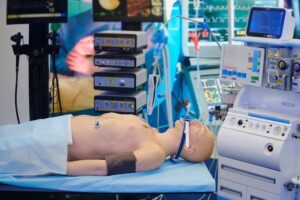Clinical Simulation Tools for Diabetes Education
Did you know that November is Diabetes Awareness Month? Each year this month is observed to raise awareness with individuals, healthcare professionals, organizations, and communities across the country who are directly or indirectly affected by Diabetes. Today, we take a closer look at Diabetes and some of the key healthcare simulation learning theories from Dr. Kim Baily and helpful educational tools Pocket Nurse provides to help educators teach this this serious disease.
Diabetes education is paramount to improving patient outcomes. Today diabetic simulation scenarios in nursing and medical education are well documented and highly effective. With the extensive amount of hands-on learning in safe environments that it offers, clinical simulation is a proven way to educate future and existing healthcare workers.
Dr. Baily writes in her ongoing series Physiology: The Force Behind Healthcare Simulation – A Guide for Techs, Part 4: Diabetes that “Diabetic patients are prone to fluctuating blood sugars which must be treated promptly to prevent serious consequences. Later articles will discuss treatment of high blood glucose (hyperglycemia) and low blood sugar (hypoglycemia). Both situations make ideal simulation scenarios.”
Sponsored Content:
She goes on that “An estimated 30.3 million people of all ages—or 9.4% of the U.S. population—had diabetes in 2015. This total included 30.2 million adults aged 18 years or older (12.2% of all U.S. adults), of which 7.2 million (23.8%) were not aware of or did not report having diabetes. At least one in four hospitalized patients has diabetes. Medical simulation provides an opportunity for learners to care for patients with diabetes either as the primary admitting diagnosis or as a comorbidity.”
You can read the additional Diabetes articles in Dr. Baily’s Series Covering these sub topics:
- Part 4B: Hypoglycemia & Excel Template for Simulated EHR
- Part 4C: Insulin
Diabetes Education: Tools for Educators
Pocket Nurse is committed to offering a variety of educational solutions for the simulation lab and classroom with some very unique products supporting educators with diabetes training.
Sponsored Content:
GlucoSim Simulated Glucometer: This simulated device is designed by a nurse, Dr. Wendy Crary, in order to help develop critical thinking and clinical reasoning in students. The GlucoSim gives instructors a realistic assessment tool for the simulation environment. It is easy to use, and looks and feels like a real glucometer. A glucometer is a device used to measure blood sugar by detecting the level of glucose in a person’s blood.
SA Fingerstick Kit: This kit is comprised of an overlay finger model, a container for mixing up a simulated blood sugar solution, recipes for the solution, and a syringe to inject the solution into the finger overlay. The finger model can be placed over a thumb or large finger of a standardized participants or manikins, and students can practice finger sticks to test capillary blood sugars with a glucometer – or with the GlucoSim. The recipes provided allow instructors to prepare low, normal, and high-blood glucose solutions.
Diabetes Skills Training Kit: This kit offers a comprehensive selection of product solutions to teach students to practice typical diabetes-related care scenarios. It includes a glucometer and its related equipment, lancets, several Demo Dose® Simulated Medication solutions, an Inject-Ed™ trainer, exam gloves, and prep pads. The skills training kit helps teach students about how diabetes is managed with insulin.
Demo Dose Simulated Insulin: Insulin is a hormone that helps the body regulate sugar in the blood stream and store excess glucose for energy. In diabetes, the body doesn’t product insulin or cannot use the insulin it produces. Insulin therapy helps replace insulin in Type 1 diabetes, or helps regulate blood glucose in Type 2 and gestational diabetes.
Not all therapeutic insulin is the same! There are different types of insulin depending on how quickly they work, when they peak, and how long they last. Pocket Nurse provides a bundle of Demo Dose Simulated Insuln for instructors to teach about the different types of insulin, and how and when they are used.
Using these diabetes education tools in the classroom will help healthcare professionals from the clinic to the hospital, and improve patient outcomes.
More About Diabetes for Simulation Technicians
Diabetes is a complex, chronic condition that affects more than 30 million people in the United States, which is equivalent to 1 in 10 Americans. The strong correlation between diabetes, heart disease, and stroke makes it a condition that must be taken seriously.
The three major types of diabetes are Type 1, Type 2, and gestational diabetes.
Type 1 diabetes is also called insulin-dependent diabetes. It is a chronic autoimmune condition that usually shows up in childhood and is caused by the body attacking its own pancreas with antibodies. The damaged pancreas is unable to produce insulin as a result. Only about five percent of people with diabetes have Type 1.
The most common form of diabetes is Type 2; it accounts for 95 percent of adult diabetes cases. People with Type 2 diabetes are unable to use the insulin that their bodies produce, which is why it’s also called insulin-resistant diabetes. Health conditions such as obesity result in the cells in the body being resistant to insulin absorption. Although Type 2 diabetes is considered less serious than Type 1, it still causes myriad health complications in the smallest blood vessels in the body that perfuse the kidneys, nerves, and eyes. This type of diabetes also increases your risk of heart disease and stroke.
Gestational diabetes, as the name implies, is triggered by pregnancy. It is usually diagnosed in the second or third trimester. Because high blood sugar levels in a mother are circulated through the placenta to the baby, gestational diabetes must be controlled to protect fetal growth and development. Although gestational diabetes usually resolves after pregnancy, studies have shown that it increases a mother’s risk for developing Type 2 diabetes later in life.
Learn More About Diabetes Simulation Tools From Pocket Nurse!
Today’s article was guest authored by Dawn Mangine, Content Manager at Pocket Nurse, and edited by Lance Baily.
Have a story to share with the global healthcare simulation community? Submit your simulation news and resources here!
Dawn Patton Mangine is Content Manager for Pocket Nurse, a leading manufacturer and distributor of healthcare simulation education supplies. Dawn has been with Pocket Nurse since April of 2016. As content manager, she has created and manages SimTalk Blog, a space for topics on simulation and healthcare education. She also curates the Pocket Nurse Twitter and Instagram feeds. Dawn is a creator and story teller, and lives in Pittsburgh with her family (husband, three children, and one dog.)
Sponsored Content:




















